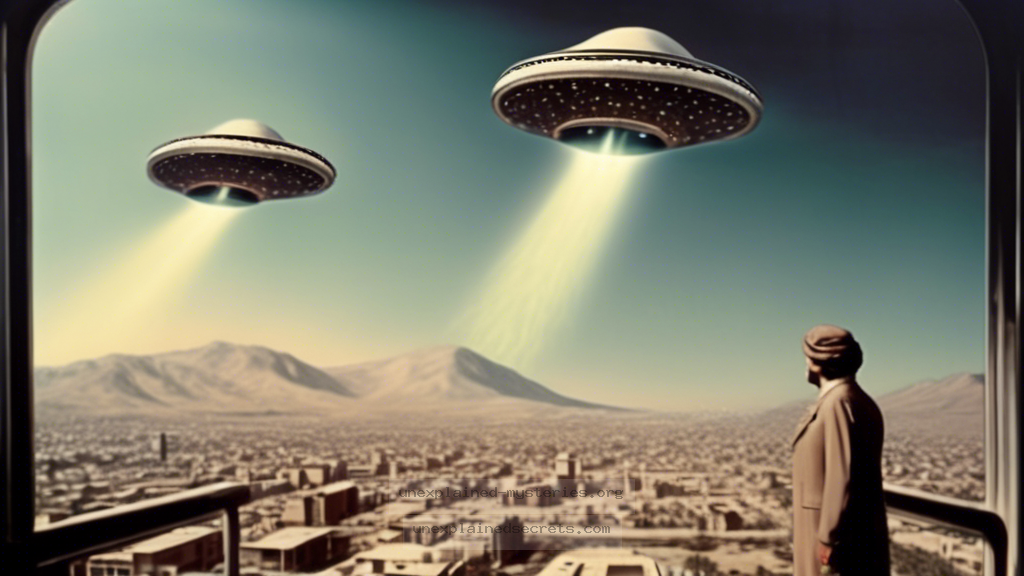What Really Happened During the 1976 Tehran UFO Incident?
What Really Happened During the 1976 Tehran UFO Incident?
The 1976 Tehran UFO incident remains one of the most compelling and well-documented cases of unidentified flying objects (UFOs) and potential extraterrestrial encounters in modern history. This incident not only captivated the public’s imagination but also raised questions about military protocols, government secrecy, and the possible existence of extraterrestrial life. As we delve into this mystery, we’ll explore the events of that night, the witnesses involved, and the implications of this encounter on our understanding of UFOs and alien life.
Historical Context: The Cold War and Iran’s Political Climate
The Tehran UFO incident occurred on September 19, 1976, during a time of significant tension in the Middle East and the global geopolitical landscape. The Cold War was at its height, and the Iranian Revolution was brewing beneath the surface, leading to drastic shifts in power dynamics. Iran was an ally of the United States, and the military was heavily engaged in surveillance and defense operations. The backdrop of political instability and military vigilance sets the stage for the extraordinary events that were about to unfold.
Timeline of Events: The Night of the Sighting
On the night of September 19, Iranian Air Force pilots received reports of an unidentified object in the skies near Tehran. The first sighting was reported around 1:30 AM, when a glowing object was seen hovering over the city. The military scrambled two F-4 Phantom fighter jets to intercept the object. As the pilots approached the location, they experienced a series of strange phenomena:
- Initial Contact: The first F-4 pilot reported seeing a bright light that appeared to be hovering. As he attempted to pursue it, his instruments began to malfunction.
- Disabling Systems: The second pilot experienced similar issues, as his radar and communication systems were rendered useless, leaving him unable to relay crucial information back to base.
- Witness Accounts: Ground personnel and civilians reported seeing the object change colors and perform rapid maneuvers, far beyond the capabilities of any known aircraft.
Core Concepts: Analyzing the Evidence
The evidence surrounding the Tehran UFO incident has been analyzed from various perspectives, leading to several core theories:
- Extraterrestrial Hypothesis: Some researchers argue that the object could be of extraterrestrial origin, given its advanced capabilities and the pilots’ inability to identify it.
- Military Experimentation: Others suggest it may have been a secret military craft or technology being tested at the time.
- Atmospheric Phenomenon: Some skeptics propose that the object could have been a rare atmospheric phenomenon, although this does not account for the pilots’ instrument malfunctions.
Practical Implications: Military Response and Protocols
The Tehran incident highlights significant implications for military response to UFO sightings. The Iranian Air Force was faced with a situation that required immediate action but also raised concerns about protocols and communication. The pilots’ inability to communicate effectively demonstrates the potential chaos that can arise during unexplainable events. This incident prompted the Iranian military to reassess its approach to unidentified aerial phenomena (UAPs) and develop protocols for future encounters.
Alternative Perspectives: Skeptics vs. Believers
As with many UFO sightings, the Tehran incident has its share of skeptics and believers. Skeptics argue that the incident can be easily explained through misidentification of conventional aircraft or atmospheric phenomena. They point to the lack of concrete evidence, such as physical artifacts or definitive proof of extraterrestrial technology. On the other hand, believers argue that the sheer number of credible witnesses and the military’s inability to identify the object lend credence to the extraterrestrial hypothesis. This divide in perspectives reflects the broader debate surrounding UFOs and governmental transparency.
Common Misconceptions: Debunking the Myths
Several misconceptions have arisen from the Tehran UFO incident that merit clarification:
- Myth 1: All UFO sightings are hoaxes or misidentifications.
Reality: While some may be attributed to man-made objects or natural phenomena, many sightings, including Tehran, defy simple explanations. - Myth 2: The Iranian military has been entirely dismissive of the incident.
Reality: The military took the incident seriously, conducting investigations and attempts to identify the craft. - Myth 3: Eyewitness accounts are unreliable.
Reality: Eyewitness testimonies, especially from trained military personnel, can provide valuable insights into unexplained events.
Best Practices for UFO Investigation and Study
Investigating UFO sightings requires a systematic approach. Here are some best practices for researchers and enthusiasts alike:
- Document Everything: Record eyewitness accounts, timestamps, and environmental conditions at the time of the sighting.
- Engage with Experts: Consult with aerospace engineers, astronomers, and other experts to analyze the evidence critically.
- Seek Collaboration: Work with established UFO research organizations that have experience in handling such investigations.
- Maintain Objectivity: Avoid jumping to conclusions and remain open to various explanations, both conventional and unconventional.
Future Developments: Ongoing Research and Government Transparency
In recent years, there has been a noticeable shift in governmental attitudes toward UFOs. The U.S. Department of Defense has established the Unidentified Aerial Phenomena Task Force, emphasizing transparency and investigation. The Tehran incident remains a pivotal study case as researchers continue to analyze the implications of military encounters with UAPs. Future developments may include:
- Increased funding for UFO research.
- Collaborative efforts between countries to investigate sightings.
- Greater public disclosure of previously classified information.
Conclusion: The Legacy of the Tehran UFO Incident
The 1976 Tehran UFO incident serves as a compelling chapter in the ongoing exploration of unidentified aerial phenomena. With a wealth of credible witnesses and documented military engagement, it challenges our understanding of what lies beyond our planet. As we move forward, the lessons learned from this incident can guide future investigations, encourage open dialogue, and perhaps even lead us closer to discovering whether we are truly alone in the universe. By embracing a balanced approach to investigation and fostering transparency, we can navigate the mystery of UFOs with both curiosity and caution.
Other Articles
Recent Posts
- What Happened to Flight MH370? The Conspiracy Theories That Still Haunt Us
- What Secrets Lurk Within the Walls of the Infamous Trans-Allegheny Lunatic Asylum?
- What Evidence Supports the Existence of Bigfoot in the Pacific Northwest?
- What Happened to the Indus Valley Civilization? Unraveling the Mysteries of Ancient Urban Life
- Can Telepathy Be Scientifically Proven Through Laboratory Evidence?







